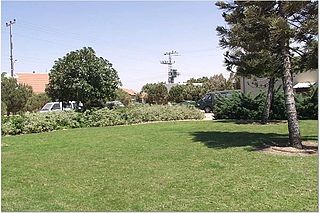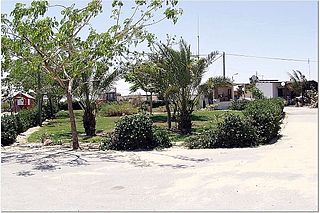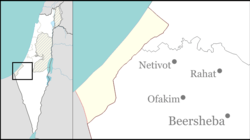
In 2005, 21 Israeli settlements in the Gaza Strip and four Israeli settlements in the West Bank were unilaterally dismantled. Israeli settlers and army evacuated from inside the Gaza Strip, redeploying its military along the border. The disengagement was conducted unilaterally by Israel; in particular, Israel rejected any coordination or orderly hand-over to the Palestinian Authority. Despite the disengagement, the Gaza Strip is still considered to be occupied under international law.
The Murder of the Hatuel family was a shooting attack on May 2, 2004, in which Palestinian militants killed Tali Hatuel, a Jewish settler, who was eight months pregnant, and her four daughters, aged two to eleven. The attack took place near the Kissufim Crossing near their home in Gush Katif bloc of Israeli settlements in the Gaza Strip during the Second Intifada. After shooting at the vehicle in which Hatuel was driving with her daughters, witnesses said the militants approached the vehicle and shot the occupants repeatedly at close range.

Gush Katif was a bloc of 17 Israeli settlements in the southern Gaza Strip. In August 2005, the Israel Defense Forces removed the 8,600 Israeli residents from their homes after a decision from the Cabinet of Israel. The communities were demolished as part of Israel's unilateral disengagement from Gaza.

Neve Dekalim was an Israeli settlement in the Gaza Strip. Comprising a part of Gush Katif, it was founded in 1983, shortly after Israel withdrew from the Sinai Peninsula to fulfill the Egypt–Israel peace treaty. It served as a regional centre for the Gush Katif settlement bloc and was the seat of the defunct Hof Aza Regional Council. The settlement was located in between the Mediterranean Sea and the Khan Yunis refugee camp. In August 2005, Neve Dekalim was dismantled by the Israeli government in pursuit of the Disengagement Plan Implementation Law, which had been approved by the Knesset six months earlier.

Kfar Darom was a kibbutz and an Israeli settlement within the Gush Katif bloc in the Gaza Strip.

Netzarim was an Israeli settlement in the Gaza Strip about 5 kilometers southwest of Gaza City. It was established in 1972. In August 2005, the inhabitants of Netzarim were evicted by the Israel Defense Forces (IDF) as part of Israel's unilateral disengagement plan.

Morag was an Israeli settlement organized as a moshav in the Gush Katif settlement bloc. in the south-west edge of the Gaza Strip. It was evacuated as part of Israel's unilateral disengagement plan of 2005.

Bedolah was an Israeli settlement and army base in the Gush Katif settlement bloc, located in the southwest edge of the Gaza Strip. Home to 220 religious Jews, its inhabitants were evicted, its houses demolished, and its land surrendered to the Palestinian National Authority as part of Israel's disengagement of 2005.

Bnei Atzmon was an Israeli settlement previously in the Sinai Peninsula, later moved to the Gaza Strip before being destroyed in 2005.
Slav was an Israeli settlement in the Gush Katif settlement bloc, located in the south-west edge of the Gaza Strip until 2005.
Tel Katifa, was a small Israeli settlement located in the northeast end of the Gush Katif settlement bloc of the Gaza Strip, and evacuated in Israel's disengagement of 2005.
Kerem Atzmona was an unauthorized Israeli outpost in the Gush Katif settlement bloc, located in the south-west edge of the Gaza Strip, and evacuated as part of Israel's unilateral disengagement plan of 2005.
Rafiah Yam was an Israeli settlement, in the Gaza Strip until 2005.
Nisanit was the largest Israeli settlement in the northern tip of the Gaza Strip in a mini-settlement bloc including Elei Sinai and Dugit. While Nisanit was under the municipal authority of the Hof Aza Regional Council it was not physically in the Gush Katif bloc where the bulk of the 'Gush Katif' settlements were located.

Dugit was an Israeli settlement located in the northern tip of the Gaza Strip closest to the shore of the Mediterranean Sea in a mini-settlement bloc including Elei Sinai and Nisanit. While Dugit was under the municipal authority of the Hof Aza Regional Council it was not physically in the Gush Katif bloc where the bulk of the Gush Katif settlements were located.

Elei Sinai was an Israeli settlement in the north of the Gaza Strip.

Nadia Matar (Pikovitch) is a right wing activist in Israel. A Yavneh Olami youth leader, she performed aliyah (immigrated) alone at the age of 18 in 1984, while still in her teens, and married an American doctor, David, a pediatrician at Hadassah Hospital, with whom she has had six children, and settled in Efrat, though she moved her family to Shirat HaYam in Gush Katif in 2004 when Ariel Sharon decided to dismantle Jewish settlements in the Gaza Strip. She has been called by some admirers 'the settlers' Joan of Arc'. She is, together with Yehudit Katsover, the co-chairman of the Nationalist organization Women in Green. She hosts a settler radio show.

Maskiot is an Israeli settlement in the West Bank. Located in the northern Jordan Valley, it falls under the jurisdiction of Bik'at HaYarden Regional Council. In 2022 it had a population of 343.
Dikla was an Israeli settlement in the northeastern part of the Sinai Peninsula established during Israel's occupation of the peninsula from the end of the 1967 Six-Day War, until that part of the Sinai was handed over to Egypt in 1982 as part of the terms of the 1979 Egypt–Israel peace treaty.

Israel had dismantled its settlements in Gaza in its unilateral withdrawal from the area in 2005, after 38 years of settlers living in the Gaza Strip, and Prime Minister Benjamin Netanyahu has claimed that, "Israel has no intention of permanently occupying Gaza or displacing its civilian population," he further alleged that, "Israel is fighting Hamas terrorists, not the Palestinian population, and we are doing so in full compliance with international law". In the context of the Israel–Hamas war, some Israelis have proposed expulsion of or creating conditions leading to the exodus of Palestinians from the area and a new wave of resettlement of the Gaza Strip.














